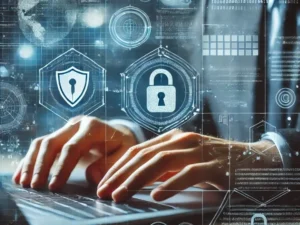This section introduces the EU Cybersecurity Act, highlighting its goals, the role of ENISA, and the establishment of a unified EU-wide cybersecurity certification framework. It explains how certification enhances consumer trust, ensures compliance across member states, and provides businesses with strategic and operational benefits while outlining the risks of non-compliance.
Cybersecurity Laws and Regulations
This course provides SMEs with essential knowledge of cybersecurity laws and regulations—such as GDPR, NIS2, and sector-specific requirements—and equips them ...
Show more
- Description
- Curriculum
- Reviews

In today’s digital landscape, cybersecurity is no longer optional—it’s a legal obligation. This course is designed to equip Small and Medium-Sized Enterprises (SMEs) with a practical understanding of key cybersecurity laws, regulations, and compliance strategies across the EU and beyond.
Participants will explore critical legal frameworks such as the General Data Protection Regulation (GDPR), NIS2 Directive, and the EU Cybersecurity Act, alongside sector-specific rules for finance, healthcare, and e-commerce. The course also highlights best practices for data breach notification, third-party risk management, employee training, and incident response planning.
By the end of the course, learners will be able to:
-
Recognize legal obligations and risks in handling personal and business data.
-
Implement compliance measures that align with GDPR and NIS2 requirements.
-
Understand the implications of global standards (e.g. ISO/IEC 27001, NIST).
-
Anticipate emerging laws such as the EU AI Act and Digital Services Act.
-
Access practical tools, templates, and support resources to sustain compliance.
Whether you’re a business owner, IT lead, or compliance officer, this course provides essential knowledge and guidance to help you protect your organisation, meet regulatory expectations, and build trust with customers and partners.
Getting Started: Why Cybersecurity Law Matters for SMEs
Introduction to Cybersecurity Laws and Regulations
-
2What is Cybersecurity Law? An Overview and Its Importance for Businesses
This section introduces the concept of cybersecurity law, explains why it is critical for modern businesses, and outlines how legal frameworks help protect data, prevent cybercrime, and build trust in a digital environment.
-
3Why SMEs Are Targeted: Understanding Cybersecurity Risks and Legal Implications
This section explores why SMEs are frequent targets of cyberattacks, highlighting their common vulnerabilities, limited resources, and legal obligations. It emphasizes the growing risks and outlines the consequences of non-compliance with cybersecurity regulations.
-
4Protecting Your Business Through Cybersecurity Compliance
This section introduces the importance of cybersecurity laws for SMEs, outlining the risks they face, the legal consequences of non-compliance, and the critical role of regulation in protecting data, maintaining trust, and ensuring business continuity.
-
5Activity: Cybersecurity Laws & Regulations
Learning Objectives
- Understand what cybersecurity law encompasses
- Identify why SMEs are targeted by cybercriminals
- Recognize legal implications of non-compliance
- Apply knowledge to real-world scenarios
Overview of Key Cybersecurity Regulations
-
6Key Cybersecurity Regulations for Businesses
This section introduces the three core EU cybersecurity regulations—GDPR, NIS2, and the Cybersecurity Act—explaining their purpose, scope, and impact on business operations, and why compliance is essential for legal protection, trust-building, and cyber resilience.
-
7General Data Protection Regulation (GDPR): Data Protection, Data Breach Notification, and Rights of Individuals
This section provides a comprehensive overview of the GDPR, focusing on its core data protection principles, breach notification obligations, and the expanded rights of individuals. It highlights the importance of GDPR compliance for businesses aiming to protect personal data, maintain transparency, and build trust in today’s data-driven economy.
-
8Network and Information Systems Directive (NIS2 Directive): Requirements for Critical Infrastructure Protection and Risk Management
This section provides an in-depth overview of the NIS2 Directive, the EU’s updated cybersecurity framework for critical infrastructure. It outlines expanded sectoral scope, mandatory risk management practices, stringent incident reporting requirements, governance obligations, and enforcement measures—offering businesses clear guidance to enhance cyber resilience and comply with EU law.
-
9Cybersecurity Act (EU): Introduction to the EU Cybersecurity Act and Its Implications on Cybersecurity Certifications for Businesses
-
10Navigating Key Cybersecurity Regulations
This section summarizes the key EU cybersecurity regulations—GDPR, NIS2, and the Cybersecurity Act—emphasizing their importance for legal compliance, risk reduction, and building digital trust. It prepares learners to transition into the next module on sector-specific regulations by highlighting the growing need for industry-tailored cybersecurity strategies.
-
11Activity: GDPR, NIS2, and the EU Cybersecurity Act
Test your understanding of GDPR, NIS2, and the EU Cybersecurity Act
Sector-Specific Cybersecurity Regulations
-
12Understanding Sector-Specific Cybersecurity Regulations
This section introduces key cybersecurity regulations tailored to high-risk industries—finance, healthcare, and e-commerce—highlighting the unique legal and security requirements SMEs must meet to protect sensitive data and ensure compliance in their specific operational environments.
-
13Financial Sector: Specific Regulations for SMEs Operating in Financial Services
This section outlines the key cybersecurity and compliance obligations for SMEs operating in the financial services sector, focusing on the EU’s PSD2 and MiFID II regulations. It highlights requirements such as strong customer authentication, investor protection, transparency, and incident reporting—providing SMEs with the foundational knowledge to operate securely and legally in a highly regulated industry.
-
14Healthcare: Legal Frameworks for SMEs in Healthcare
This section outlines the key legal and cybersecurity obligations for SMEs in the healthcare sector, focusing on GDPR, eHealth regulations, NIS2, and the EU Cybersecurity Act. It highlights how SMEs must protect patient data, ensure secure digital health services, and comply with cross-border and cybersecurity requirements to maintain trust, legal compliance, and service quality in an increasingly digital healthcare environment.
-
15E-Commerce: Data Protection and Security Requirements for SMEs Involved in E-Commerce
This section outlines the essential data protection and cybersecurity requirements for SMEs in the e-commerce sector, focusing on compliance with GDPR and PCI-DSS, the use of secure payment gateways, SSL/TLS encryption, and best practices such as two-factor authentication and regular security audits. It emphasizes how these measures protect customer data, prevent fraud, ensure regulatory compliance, and build long-term consumer trust.
-
16From Finance to E-Commerce: What SMEs Must Know
This section summarizes the unique cybersecurity and data protection requirements for SMEs in the financial, healthcare, and e-commerce sectors. It highlights key regulations such as PSD2, MiFID II, GDPR, NIS2, and PCI-DSS, emphasizing how compliance safeguards sensitive data, builds consumer trust, and ensures operational continuity. The module concludes by setting the stage for the next section on legal consequences and best practices for achieving full regulatory compliance.
-
17Activity: CyberSafe SME Training
Select the sector that best matches your business to begin targeted cybersecurity training
Legal Compliance and Best Practices for Cybersecurity in SMEs
-
18Key Legal Requirements for SMEs
This section outlines the key legal responsibilities that Small and Medium-sized Enterprises (SMEs) must fulfill to ensure cybersecurity compliance. It covers essential areas such as data breach notification procedures, mandatory security measures, third-party risk management, and employee training. With a focus on GDPR, the NIS2 Directive, and other applicable frameworks, it provides actionable guidance to help SMEs meet regulatory obligations, reduce cybersecurity risks, and foster a culture of data protection across the organization.
-
19Legal Consequences of Non-Compliance
This section highlights the serious implications SMEs may face when failing to comply with cybersecurity and data protection regulations such as GDPR and NIS2. It outlines the range of consequences—from heavy financial penalties and reputational damage to increased litigation risks—and emphasizes the importance of proactive compliance to safeguard business continuity, trust, and legal standing.
-
20Best Practices for Compliance
This section outlines essential best practices SMEs should adopt to ensure effective compliance with cybersecurity and data protection laws. It covers the development of a tailored cybersecurity strategy, the creation of clear privacy policies, the importance of incident response and disaster recovery planning, and the value of certifications and audits. Together, these practices help SMEs strengthen their security posture, meet regulatory obligations, and build resilience against evolving cyber threats.
-
21Conclusion: Turning Compliance into Competitive Advantage
This final section summarizes the key legal requirements and best practices SMEs must follow to ensure cybersecurity compliance and operational resilience. It emphasizes the importance of proactive measures—such as breach notification, third-party risk oversight, and employee training—and encourages SMEs to view compliance not as a burden but as a strategic asset that fosters trust, minimizes risk, and supports sustainable growth.
-
22Activity: Cybersecurity Compliance Assessment
Advanced Training Module for SME Employees
Looking Ahead: Global Compliance, Future Regulations, and Support for SMEs
-
23Global Considerations
This section explores the global dimensions of cybersecurity compliance for SMEs, focusing on cross-border data transfer obligations under GDPR and the importance of aligning with international standards such as ISO/IEC 27001 and the NIST Cybersecurity Framework. It highlights how SMEs can navigate legal requirements and enhance their credibility and security posture when operating across jurisdictions.
-
24Future Trends and Emerging Regulations
This section highlights emerging legal developments and regulatory trends that will impact SMEs in the near future, including the EU Artificial Intelligence Act, Digital Services Act, and evolving cybersecurity laws. It emphasizes the growing importance of board-level accountability, supply chain risk management, and real-time incident reporting. By staying informed and adapting early, SMEs can navigate legal changes effectively and build long-term digital resilience.
-
25Resources for Compliance
This section provides an overview of practical tools and professional services available to help SMEs meet their cybersecurity and data protection obligations. It highlights digital compliance checkers, policy templates, incident response platforms, and employee training tools, along with scenarios where legal or cybersecurity experts may be needed. These resources support SMEs in building effective, affordable, and legally sound cybersecurity programs.
-
26Final Reflections: Strengthening SME Cybersecurity Through Legal Awareness
This final section summarizes the course’s core insights, emphasizing that legal compliance is a critical component of cybersecurity for SMEs. It reinforces the importance of aligning with GDPR, NIS2, and sector-specific laws, while adopting best practices and staying informed about evolving regulations. By viewing compliance as a strategic enabler rather than a burden, SMEs can strengthen their resilience, build trust, and secure long-term digital success.
-
27References and Further Reading
This section compiles key sources used throughout the course, offering learners access to foundational texts, official guidelines, and expert insights on cybersecurity and data protection compliance for SMEs. The references include EU regulatory portals, academic research, industry white papers, and practical guides covering GDPR, NIS2, the EU Cybersecurity Act, and sector-specific laws. Learners are encouraged to explore these resources for deeper understanding and to stay updated on evolving legal and cybersecurity requirements.
Cybersecurity Laws and Regulations Training – Course Evaluation Survey
Please, login to leave a review




